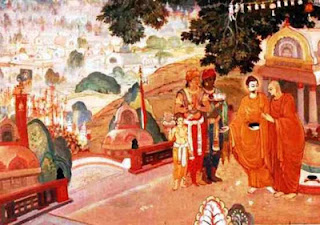Chhath Puja also called Dala Puja is a Hindu festival popular in the Northern and Eastern Indian states of Bihar and Jharkhand The word ‘Chhath’ has its origin in ‘sixth’ as it is celebrated on the 6th day or ‘Shasthi’ of the lunar fortnight of Kartik (October - November) in the Hindu calendar – six days after Diwali, the festival of lights.
-- A RITUAL DEDICATED TO SUN GOD --
** Chhath is mainly characterised by riverside rituals in which the Sun God or Surya is worshipped, giving it the name of ‘Suryasasthi.’ It underpins the ever so scientific belief that the Sun God fulfils every wish of earthlings and so it’s our duty to thank the sun with a special prayer for making our planet go round and bestowing living beings with the gift of life. The ghats or riverbanks throng with devotees as they come to complete their ritual worship or ‘Arghya’ of the sun – both at dawn and dusk. The morning ‘Arghya’ is a prayer for a good harvest, peace and prosperity in the new year and the evening ‘Arghya’ is an expression of thanks to the benevolence of the Sun God for all that he has bestowed during the year gone by.
-- HOW CHHATH IS CELEBRATED --
** Chhath can well be regarded as the state festival of Bihar, where it goes on for four days. Outside of India, Chhath is mainly among celebrated by the Bhojpuri and Maithili speaking community apart from the Nepalese Hindus. It assumes a joyous and colourful form as people dress up in their best clothes and gather by rivers and other water bodies to celebrate Chhath. Many devotees take a holy dip at dawn before preparing the ritual offerings or ‘prasad,’ which mainly comprising ‘Thekua,’ a hard and crude but tasty wheat-based cake usually cooked on traditional earthen ovens called ‘Chulhas.’ The divine offerings are placed on circular trays woven out of bamboo strips called ‘dala’ or ‘soop.’ Women adorn new clothes, light lamps and sing devotional folk songs in honour of ‘Chhathi Maiya’ or the holy river Ganga. After sunset, devotees return home to celebrate ‘Kosi’ when earthen lamps or ‘Diyas’ are lit in the courtyard of the house and kept beneath a bower of sugarcane sticks. Serious devotees maintain a strict anhydrous fast of three days..
-- THE 4 DAYS OF CHHATH --
## The first day of Chhath is called ‘Nahai Khai,’ which literally means ‘bath and eat’ when devotees bathe in the river, preferably a holy one such as the Ganga and bring home the water to cook food offerings for the Sun God.
## On the second day called ‘Kharna,’ the devotees observe 8-12 hours of anhydrous fast and end their ‘Vrat’ in the evening after performing Pooja with the ‘Prasad’ offered to Surya. This normally consists of ‘payasam’ or ‘kheer’ made rice and milk, ‘Puris,’ fried bread made of wheat flour, and bananas, which are distributed to one and all at the end of the day.
## The third day is also spent in worship and preparing ‘Prasad’ while fasting sans water. This day is marked by the elaborate evening ritual called the ‘Sandhya Arghya’ or ‘evening offering.’ The offerings are served to the setting sun on bamboo trays that has ‘Thekua,’ coconut, and banana among other fruits. This is followed by the ‘Kosi’ ritual in homes.
## The fourth day of Chhath is considered the most auspicious when the final morning ritual or ‘Bihaniya Arghya’ is performed. The devotees along with their family and friends congregate on the bank of the river to offer ‘Arghyas’ to the rising sun. Once the morning ritual is over, devotees break their fast by taking a bite of ginger with sugar. This marks the end of the rituals as joyous celebrations ensue.
-- LEGENDS AROUND CHHATH PUJA --
** It is said that in the times of the Mahabharata, Chhath Puja was performed by Draupdi, the wife of Pandava Kings. Once during the long exile from their kingdom, thousands of wandering hermits visited their hut. Being devout Hindus, the Pandavas were obliged to feed the monks. But as exiles, the Pandavas were not in a position to offer food to so many hungry hermits. Seeking a quick solution, Draupadi approached Saint Dhaumya, who advised her to worship Surya and observe the rituals of the Chhath for prosperity and abundance



































